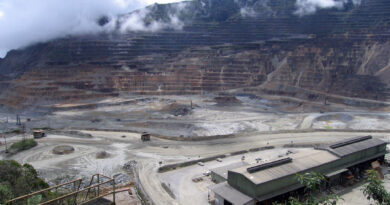Installing monolithic refractories in rotary kilns
Yearly global refractory consumption in the production of cement is estimated to be more than 5 million metric tons, or 12% of the total world refractory market, and growing. Monolithic refractory makes up a good chunk of that market, as much as 40%, and rightfully so. It’s faster and easier to install than refractory brick, which is why as much as 2.3 million metric tons of monolithic refractory is used each year.
Because of equipment improvements and material innovations – such as no-cement, colloidal silica, which offers optimal alkali resistance and bonding properties – contractors are installing monolithic refractories in areas of cement kilns once reserved for brick refractory. This includes the nose ring and tail ring, which is also called the inlet cone. These improvements and innovations also are making it easier and more cost-effective for brick refractory contractors to make the switch.
There are three methods contractors use to install monolithic refractory materials:
- cast-in-place, also known as form-and-pour;
- using wet shotcrete methods to spray in place without the use of forms; or
- using the dry process method of spraying in place without the use of forms, also known as the gunite process.
Cast-In-Place
The most popular placement process for monolithic refractory installation over large areas is the cast-in-place method. In some cases, this method is the only means of placing the material. Contractors can mix precise amounts of water with material and monitor each batch to ensure a homogenous mixture is achieved, which maximizes batch quality. Once the material has been mixed properly, it is loaded into a high-pressure swing tube concrete pump and the material is pumped and vibrated in place.
The major advantages of cast-in-place installation are optimal quality control and a smooth finished surface, which minimizes abrasion to the material placed in the kiln. A smooth surface also provides optimal flow in and out of the kiln with little resistance.
Wet Shotcrete
In addition to cast-in-place, the use of the wet shotcrete process is also popular when lining a large area but is the preferred method when installation speed is critical to maximizing productivity and profits. Contractors use the same mixing and pumping equipment as for the cast-in-place process but omit the forms – thus the common name of “formless concrete.” The wet shotcrete method also requires contractors to use materials specifically designed for being sprayed.
One key difference between the cast-in-place and shotcrete methods is the need to add an accelerator to the material as it’s discharged through the nozzle and out the delivery line. This liquid chemical allows the material to begin setting immediately upon impact as it is sprayed in place, speeding up installation time and enhancing quality. Accelerator is pumped to the nozzle and controlled by the nozzleman, so this person must have adequate knowledge and experience with chemical accelerators to ensure the material will adhere to a vertical surface properly and not slump.
One of the biggest advantages of the wet shotcrete method is that the process is less labour intensive than cast-in-place methods since no forming is involved. However, there is more skill required on the nozzleman’s part to add the accelerator correctly and properly place the material.
Dry Shotcrete
The oldest process used to place shotcrete, or formless concrete, is the dry shotcrete method, also known as gunite. The versatility and low cost of rotary gunite machines has helped simplify this method that for years used pressure vessel tank machines. Rotary guns offer some key advantages, including easy portability. They also are affordable to purchase and maintain, and it’s easy to adjust material flow through the machine.
In recent years, the introduction of no-cement, colloidal silica refractory materials have enhanced the use of the dry process for cement kilns. The gunite process was typically used only in hard-to-reach areas of the kiln. Thanks to colloidal silica and its alkali resistance and bonding properties, gunite equipment can be used to install refractory in more areas of cement kilns, where smaller, more specialized installations are necessary.
Like the wet shotcrete method, the dry shotcrete process also requires a skilled nozzleman since the water is added at the nozzle of the gunite equipment as the material passes through a water jacket. However, contractors using colloidal silica material will find that the liquid addition at the nozzle is more forgiving and therefore is less dependent on the nozzleman’s skill.
Choosing right equipment
While there are three different methods for installing monolithic refractories, they all require the same setup: placing the equipment on the ground and running steel or rubber delivery line from a pump or gunite machine for material transfer. In many cases, the delivery line can exceed 100 meters in length, and much of that delivery line runs vertically, which means it’s especially important to choose a powerful, reliable machine.
The choice of any method to place monolithic refractories is dependent on the use of high-quality and dependable mixing, pumping and spraying equipment. Monolithic refractory materials used in cement kilns are dense and abrasive, so contractors must ensure their equipment can handle the conditions with minimal downtime for maintenance or repairs.
In addition, features such as swing-out hoppers and 20-minute quick-change-out 10-cm flat packs enable fast and easy maintenance. To minimize transportation costs and setup time, a mixer and pump mounted on the same chassis is ideal.
Eliminating dust during mixing
One of the newest advancements in the refractory industry is the addition of equipment used to eliminate dust generated during the mixing phase of refractory installations. For example, Blastcrete Equipment, a refractory and shotcrete equipment manufacturer, recently launched its DustAway system. This dust mitigation process includes the combination of a dust cover placed over the refractory mixer, combined with a specially made bulk bag that has a dust ruffle attached to the bottom of the bag. The dust ruffle encapsulates a flange on the mixer cover and contains the dust in the mixer as the bulk bag is unloaded into the mixer or the hopper over a gunite machine. The dust ruffle stays in place until water can be mixed with the dry material, which only takes a few seconds.
When using the dust ruffle with a gunite machine for the dry process, a small cartridge dust collector is used to collect the dust from the hopper over the gunite machine, as well as any dust that might be generated from the rotor section of the rotary gun.




